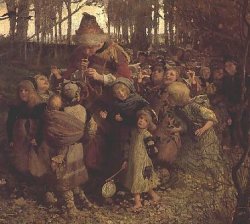 You have surely heard the story of the Pied Piper of Hamelin, a poor town in Germany during the middle ages that became infested with rats. One day a piper appeared, promising the town elders that he would rid the city of rats for a fee. They quickly agreed to pay him and the piper set about playing music that drew the rats out of the city. He led them down to the Weser River, where the rats all drowned.
You have surely heard the story of the Pied Piper of Hamelin, a poor town in Germany during the middle ages that became infested with rats. One day a piper appeared, promising the town elders that he would rid the city of rats for a fee. They quickly agreed to pay him and the piper set about playing music that drew the rats out of the city. He led them down to the Weser River, where the rats all drowned.
But when the piper demanded his payment the town elders reneged on their agreement. They chose to ignore their bargain with the stranger. He left the town but returned another day. At dawn he began playing his pipe and marching through the city. One by one many children came out of their homes and started following him. The piper led the children out of Hamelin and away toward a nearby mountain. The children were never seen again.
People have argued over the truth of this story for centuries, ever since the Brothers Grimm published it along with many other “fairy tales”. But unlike most fairy tales, the story of the piper is set in a specific year (1284). The details of the story change slightly with retelling but the fact that 130 children left Hamelin in the year 1284 has not been lost. So why such a precise numbering and dating for an old folk story?
Historian Frank Soural has published a paper in which he says that the Pied Piper story is based on a real incident. Historians have verified the fact that Hamelin lost 130 young people in the year 1284. Soural weaves an interesting tale that begins in what is now the Czech Republic (southeast of Germany) in the land of Bohemia. There a famous bishop named Bruno von Schaumburg and Holstein was recruited by the local king to recruit settlers from Germany to found new villages and cities.
Bruno did his job well and historians have much documentary evidence of the settlements that Bruno and his followers established. His method consisted of finding a reputable (wealthy) recruiter who would cull the strongest and most adventurous families from Lower Saxony to make the trek through the forested mountains of central Europe to Bohemia. These German settlers became citizens in the kingdom of Ottokar II.
Frank Soural believes that one of Bruno’s followers, or perhaps an agent of Bruno’s successor, carried on the bishop’s work in recruiting settlers from Germany for the forests of Bohemia. And he suggests that Hamelin may have been the perfect place for such an agent to find 130 young people willing to take up the arduous trek to a new home. Hamelin’s poorest people were subjected to a special labor/service tax to both the town and the local monastery. These poor people may have become weary of the endless labor and rebelled against the oppressive demands. Soural has found evidence of a trial for 130 youthful workers.
They refused to come to terms with the people of Hamelin and therefore were declared to be outlaws, excommunicated from the town and local church. Having nowhere else to go, Soural believes, the 130 youth must have accepted an invitation from the son of a visiting agent to settle in Bohemia. The young agent may have been Achilles von Heimsen, the younger. He is known to have visited Hamelin in the year 1284; and he refused to claim his father’s long-abandoned estate. Soural believes that means von Heimsen was indeed recruiting new settlers for the east.
Whether von Heimsen is supposed to be the piper or the piper was supposed to be someone else, the people of Hamelin commemorated the loss of so many young “children” for many years. Their tale eventually found its way into the folklore of Germany and instead of depicting youthful workers rebelling against oppressive masters it evolved into a story about a town plagued by rats. But the leaders of the town are nonetheless represented very poorly in the traditional story, and so it may be that Hamelin’s legacy was written by people who agreed with the 130 excommunicated workers.
This is a fascinating story and well worth the read. We may never know the full truth of the details behind the pied piper story, but Soural’s examination is really brilliant (building on the work of others, of course).
